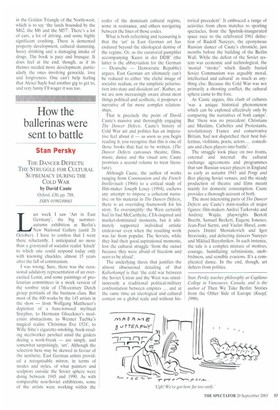How the ballerinas were sent to battle
Stan Persky
THE DANCER DEFECTS: THE STRUGGLE FOR CULTURAL SUPREMACY DURING THE COLD WAR by David Caute Oxford, £30, pp. 788, ISBN 0199249083 Last week I saw 'Art in East Germany', the big summerautumn exhibition at Berlin's New National Gallery (until 26 October). I have to confess that I went there reluctantly. I anticipated no more than a graveyard of socialist realist 'kitsch' to which one could respond today only with knowing chuckles, almost 15 years after the fall of communism.
I was wrong. Sure, there was the occasional adulatory representation of an overexcited Lenin, and some paintings of proletarian committees in a mock version of the sombre style of 17th-century Dutch group portraits of the business class. But most of the 400 works by the 145 artists in the show — from Wolfgang Mattheuer's depiction of a bare-torsoed mythical Sisyphus, to Hermann Gloeckner's modernist abstractions, to Werner Tuebke's magical realist 'Christmas Eve 1524', to Wille Sitte's cigarette-smoking, book-reading steelworker perched amid the girders during a work-break — are simply, and somewhat surprisingly, 'art'. Although the selection here may be skewed in favour of the aesthetic, East German artists provided a recognisable mirror, in terms of modes and styles, of what painters and sculptors outside the Soviet sphere were doing between 1945 and 1990. As with comparable non-Soviet exhibitions, some of the artists were working within the codes of the dominant cultural regime, some in resistance, and others navigating between the lines of those codes.
What is both refreshing and reassuring is that the 'art' in East German art has endured beyond the ideological demise of the regime. Or, as the curatorial pamphlet accompanying 'Kunst in der DDR' (the latter is the abbreviation for the German — Deutsche — Democratic Republic) argues, East German art ultimately can't be reduced to either 'the cliché image of socialist realism, or the simplistic polarisation into state and dissident art'. Rather, as we are now increasingly aware about most things political and aesthetic, it proposes a narrative of far more complex relationships.
That is precisely the point of David Caute's massive and thoroughly engaging The Dancer Defects. Caute's history of Cold War art and politics has an impera tive feel about it as soon as you begin reading it, you recognise that this is one of those books that had to be written. (The Dancer Defects canvasses theatre, films, music, dance and the visual arts: Caute promises a second volume to treat literature).
Although Caute, the author of works ranging from Communism and the French Intellectuals (1966) to a critical study of film-maker Joseph Losey (1994), eschews any attempt to impose a coherent narrative on his material in The Dancer Defects, there is an overriding framework for his story. To oversimplify: the West certainly had its had McCarthyite, CIA-inspired and market-dominated moments, but it ulti mately supported individual artistic endeavour even when the resulting work was far from popular, The Soviets, while they had their good aspirational moments, lost the cultural struggle 'from the outset because they were afraid of freedom and seen to be afraid'.
The underlying thesis that justifies the almost obsessional detailing of that Kulturkarnpf is that 'the cold war between the Soviet Union and the West was simultaneously a traditional political-military confrontation between empires ... and at the same time an ideological and cultural contest on a global scale and without his torical precedent'. It embraced a range of activities from chess matches to sporting spectacles, from the Sputnik-inaugurated space race to the celebrated 1961 defection of Rudolf Nureyev, the eponymous Russian dancer of Caute's chronicle, just months before the building of the Berlin Wall. While the defeat of the Soviet system was economic and technological, the 'mortal "stroke" which finally buried Soviet Communism was arguably moral, intellectual and cultural' as much as anything else. Because the Cold War was not primarily a shooting conflict, the cultural sphere came to the fore.
As Caute argues, this clash of cultures 'was a unique historical phenomenon which can be explored effectively only by comparing the narratives of both camps'. But 'there was no precedent: Christians and Muslims. Catholics and Protestants, revolutionary France and conservative Britain, had not dispatched their best ballerinas, violinists, poets, actors ... comedians and chess players into battle'.
The struggle took place on two fronts, external and internal: the cultural exchange agreements and programmes that saw Russian soccer players in England as early as autumn 1945 and Porg and Bess playing Soviet venues, and the steady production of theatre and films meant mainly for domestic consumption. Caute provides a thorough account of both.
The most interesting parts of The Dancer Defects are Caute's mini-studies of major figures: film-makers Andrei Tarkovsky and Andrzej Wajda. playwrights Bertolt Brecht, Samuel Beckett, Eugene Ionesco, Jean-Paul Sartre, and Vaclav Havel, composers Dmitri Shostakovich and Igor Stravinsky, and defecting dancers Nureyev and Mikhail Barysbnikov. In each instance, the tale is a complex mixture of motives, courage, humiliating submissions, snobbishness, and sensible evasions. It's a complicated dance. In the end, though, art defects from politics.
Stan Persky teaches philosophy at Capilano College in Vancouver, Canada, and is the author of Then We Take Berlin: Stories from the Other Side of Europe (Knopf, 1996).


















































































 Previous page
Previous page